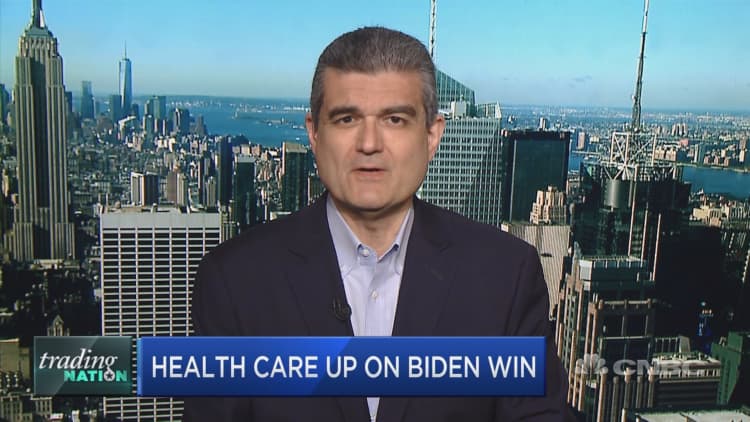
Health care stocks are surging.
The group rallied hard Wednesday following former Vice President Joe Biden's Super Tuesday sweep, with the Health Care Select Sector SPDR Fund (XLV) rising nearly 6% for the session and pacing for its best week since Nov. 2018.
The moves were largely led by UnitedHealth Group, which had its best daily performance since 2008 with a nearly 11% gain. The iShares U.S. Health Care Providers ETF (IHF) also popped — up nearly 9%, its best day since 2008 — as did the SPDR S&P Biotech ETF (XBI), which notched a more than 4.5% gain.
JC O'Hara, chief market technician at MKM Partners, saw even more room to run for the broader health-care group.
"I think it behooves investors to add a little defensive tilt to their portfolio, and I think health care ... checks all the boxes," he said Wednesday on CNBC's "Trading Nation," pointing to a chart of the XLV.
"It has a very bullish setup right here," O'Hara said. "Last year, it was mostly [in] a consolidation zone. Q4, we saw a strong breakout. Overall market weakness pulled health care back, but what I like is it pulled it back to major support. We believe that we should see a strong bounce here off of $90 and, truthfully, I think there's another 6% to the upside to test the all-time highs here."
The XLV's surge Wednesday brought it to $99.99 by the close, not far off the all-time closing high of $104.73 it hit in January. In Thursday's premarket, it was down 1.75% to $98.24.
Of the health-care stocks, O'Hara recommended sticking with one of the group's strongest long-term performers.
"We focus on price action. When we look through the health-care sector, we try to identify stocks that were still in longer-term uptrends, and the recent pullback has stabilized on key support levels. And Johnson & Johnson gives us just that," he said.
"You could see there's a series of higher lows in place. [The] uptrend's there. And we could also see the pullback landed right at 130, and that's key support," O'Hara said. "So, we think Johnson & Johnson will bounce here back up to 150, so that's why we like it at this point in time."
Johnson & Johnson shares closed at $143.48 on Wednesday after rising 6% in the session. It was slightly higher in Thursday's premarket.
Boris Schlossberg, managing director for FX strategy at BK Asset Management, said that while the U.S. stock market breathed a "huge sigh of relief" after Democratic presidential candidate Biden's surprise outperformance over Bernie Sanders on Tuesday, the main theme driving health-care stocks this year will likely still be the global spread of the coronavirus.
"I think the market is going to focus on the coronavirus as the primary dominant theme for investors," he said in the same "Trading Nation" interview. "Gilead is going to be one of the key leaders because they, and Moderna as well, ... seem to be having a lot of success, at least in early trials, for some sort of a vaccine."
But while Gilead's coronavirus vaccine trials could cultivate a "very strong pop in the near term" for its stock, one other health-care play could sustain gains over an even longer period, Schlossberg said.
"Longer term, one of the stocks that I like is Sanofi because Sanofi actually has a very, very steady long-term business in vaccines in general. And if the experts tell us something, it's that the coronavirus may be with us to stay in perpetuity, just like the flu. In other words, it's not just going to be a one-time event. It could be continuous," Schlossberg said. "If that's the case, I think Sanofi could be a big beneficiary as we go further in time."
Sanofi climbed nearly 6% in Wednesday trading to close at $50.54. Gilead rose just under 2.5% to $76.01. Moderna broke from the group to fall 1.5%, closing at $27.49.






